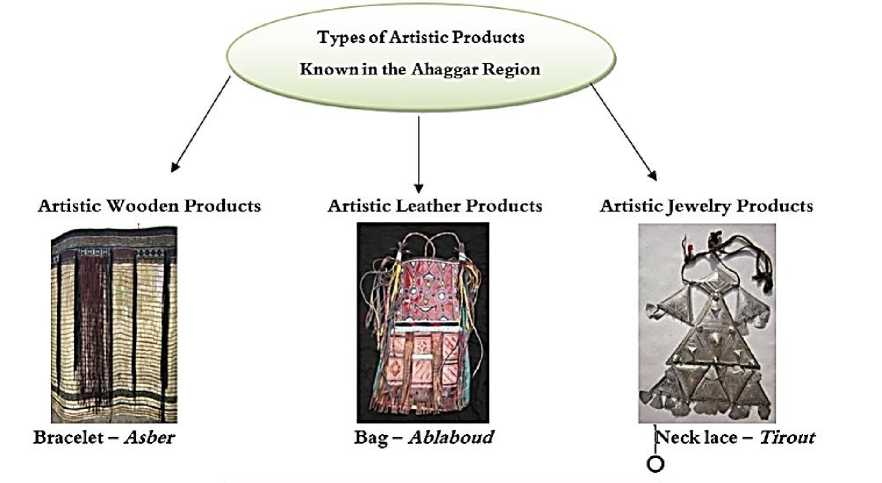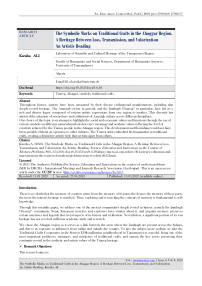The Symbolic Marks on Traditional Crafts in the Ahaggar Region. A Heritage Between Loss, Transmission, and Valorization An Artistic Reading
Автор: Karzika A.
Журнал: Science, Education and Innovations in the Context of Modern Problems @imcra
Статья в выпуске: 6 vol.8, 2025 года.
Бесплатный доступ
Throughout history, nations have been measured by their diverse civilizational manifestations, including that deeply rooted heritage. The Amazigh society in general, and the Imuhagh (Tuareg)* in particular, have left us a rich and diverse legacy composed of various artistic expressions from one region to another. This diversity has attracted the attention of researchers and enthusiasts of Amazigh culture across different disciplines. Our choice of this topic is an attempt to highlight the social and economic values and functions through the use of various symbols on different materialssymbols that carry meanings and aesthetic values reflecting the level of creativity achieved by the Tuareg people in the Ahaggar region. This development and flourishing would not have been possible without an openness to other cultures. The Tuareg artist embodied his imagination in traditional crafts, creating a distinctive artistic style that set him apart from others.
Tuareg, Ahaggar, symbols, traditional crafts
Короткий адрес: https://sciup.org/16010777
IDR: 16010777 | DOI: 10.56334/sei/8.6.38
Текст научной статьи The Symbolic Marks on Traditional Crafts in the Ahaggar Region. A Heritage Between Loss, Transmission, and Valorization An Artistic Reading
Karzika A. (2025). The Symbolic Marks on Traditional Crafts in the Ahaggar Region. A Heritage Between Loss, Transmission, and Valorization An Artistic Reading. Science, Education and Innovations in the Context of Modern Problems, 8(6), 354-366; doi:10.56352/sei/
© 2025 The Author(s). Published by Science, Education and Innovations in the context of modern problems (SEI) by IMCRA - International Meetings and Journals Research Association (Azerbaijan). This is an open access article under the CC BY license .
There is no doubt that the memory of a nation stems from the memory of its parts; the deeper the memory of these parts, the more the nation's heritage is enriched. Thus, exploring and researching the contents of memory is fundamental to selfknowledge.
Through this scientific paper, we address one of the ancient communities deeply rooted in history, namely the Imuhagh (Tuareg)* community. Some European travelers and explorers have written about it, and popular memory preserves certain narratives and legends that reveal aspects of its history and civilization. Nevertheless, a significant portion of its vast heritage has not received sufficient academic study and research.
We chose the Ahaggar region as it serves as a link between the areas where the Imuhagh are present across the Sahara, and due to its exposure to influences from within and outside the country. To give the subject more realism, we take the Traditional Crafts Cooperative in the Sourou El-Mouallemine neighborhood in Tamanrasset as a model, being one of the most important producers, managers, and marketers of traditional crafts, and among the key actors preserving their continuity rooted in the aesthetic and artistic values of the Tuareg heritage.
> Research Objectives:
This research aims to:
-
• Identify the symbolic marks present in traditional artistic products and the meanings associated with them.
-
• Open the door to interdisciplinary research in this field (integration).
-
• Shed light on a heritage threatened by loss amid current transformations.
> Research Hypotheses:
-
• It is possible to uncover the meanings and significance of symbols through study, investigation, and comparison.
> Research Significance:
-
• Provide an added value to knowledge by exploring and analyzing the meanings of these symbols.
-
• Educate specialists in the field of arts about the symbols and their artistic forms to ensure their continuity.
-
• Blend authenticity with modernity while preserving heritage from disappearance.
> Research Limits:
-
• The study focused on symbolic marks and their uses in traditional crafts, and on identifying their meanings.
> Research Methodology:
In this study, we adopted the descriptive-analytical method, without overlooking the historical method, which serves as the main pillar in archaeological art studies.
Based on this, the research problem is defined by the following questions:
-
• How do the artistic products of the Imuhagh of Ahaggar contribute to the preservation of Berber symbols?
-
• What is the aesthetic impact of decorative symbols on various products?
-
• What are the appropriate mechanisms to ensure the continuity of this heritage amid current transformations?
Study Area Definition:
The Ahaggar region is located in the heart of the Sahara Desert, serving as a connecting point between the north and the south of the desert. It lies along an ancient trade route of great importance and covers an area of 530,000 km². It is bordered by Tassilin’Ajjer to the east, Ténéré to the south, Tidikelt to the north, and to the south by Adrarn'Fughas and Aïr. The region lies between longitudes 1° to 10° East and latitudes 20° to 28° North. This strategic location has enabled it to play a mediating and supervisory role in trade exchanges between central Sahara and the Sahel. (PAUL, P. 1998, p.29)
Many of us may utter the word "Ahaggar," but few truly know its meaning. In the language of the Imuhagh, "Ahaggar" means "the great rock in a sea of sand." It is a massive rock standing amidst lands that, in the distant past, were volcanically very active. (H. Lhote, 1944, p.25)
> Reasons for Settlement:
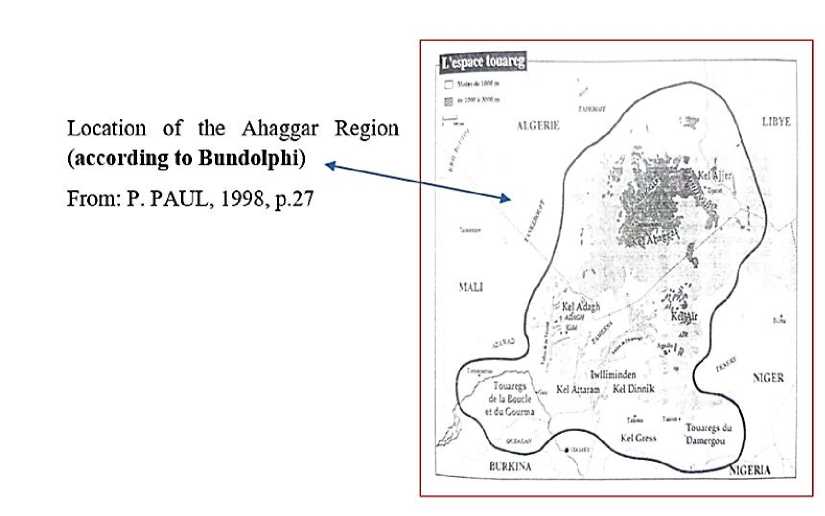
• Availability of water, arable land, pastures, and wood-gathering areas.
-
• Development of the region and the emergence of housing patterns using various building materials and techniques.
-
• Agriculture was one of the main factors behind the settlement of the nomadic Imuhagh of Ahaggar.
-
• The Ahaggar region served as a transit point for many trade caravans traveling to and from Western Sudan.
-
• The arrival of social ethnic groups from other regions (Tidikelt, Ajjer, Niger, Mali...).
-
• The positive role played by the Inedan (craftsmen) in developing the economic life of the Ahaggar region.
-
• The emergence of various handicrafts (pottery, leatherwork, jewelry making, weapons manufacturing such as swords and spears...).
Applied Art among the Imuhagh (Tuareg):
Every human civilization has its own style that embodies applied artistic production, expressing the skill and creativity of its people. This is reflected in architecture and various products such as jewelry, leather, and woodwork, as well as in the aesthetic sense visible in the quality and nature of the engravings—considered a socio-environmental production, born from the individual’s interaction with their natural and social environment.
A close examination of the geometric shapes engraved on leather, wood, and traditional jewelry reveals a simple translation of a rich artistic sensibility developed over various stages. The Tuareg man has practiced various forms of art since ancient times, as evidenced by the engravings and rock paintings known as rock art—the clear and undeniable witness to the deep roots of Tuareg art. These include geometric, animal, and human forms. These artistic artifacts are nothing but material representations of ideas and emotions, created to convey them to others or to refer back to them when needed. (LE ROI GOURHAN, 1964, p.263)
Factors Influencing the Development of Arts in the Ahaggar Region:
It is a well-known fact in the history of arts that different styles all share similarities in their developmental stages, as they are subject to a set of general factors that influence each style in its own way. These factors guide and affect the style at its inception and throughout its evolution, helping to shape its personality and characteristics. Among these factors are spiritual, intangible, and material influences.
Foremost among them is the influence of religion and spiritual beliefs, which play a decisive role in determining the type and quantity of artistic production. Religious traditions and rituals often require specific forms and types of visual and applied arts that align with their aims and fulfill their purposes. In fact, religion may use art to influence people, or people may use art to express their feelings toward their faith. (F. Chafai, 1980, p.30) This is clearly observed through the physical evidence spread across various archaeological sites in Ahaggar.
Another significant factor is the prevailing political systems in each nation, along with the resulting peace and stability or wars and unrest. Peace and stability tend to direct arts toward serving both public and private civil purposes. Friendly political relations between nations and the exchange of delegations often result in the transfer of artistic influences through gifts and trade. In contrast, during times of war or threats thereof, arts tend to serve military objectives. Wars may also lead to the presence of captive soldiers in foreign lands, which naturally results in the exchange and transfer of artistic styles from one region to another. Additionally, invaders are often influenced by the arts of the lands they conquer. A review of Ahaggar’s history reflects this notion in the development of the region.
The economic situation also significantly affects the direction of art throughout its developmental phases. Prosperity or poverty greatly influences the volume, types, and value of artistic production. Furthermore, the system of wealth distribution among the social classes leaves its mark on architecture and art products, illustrating the varying living standards of each class.
Crafts and Traditional Industries in the Ahaggar Region:
Crafts and traditional industries are an expression of cultural and social awareness, conveyed through creativity in various forms of production rooted in the environment in which the individual lives.
UNESCO defines them as:“Products made by artisans either entirely by hand, or with the help of hand tools or even mechanical means, provided that the artisan’s direct manual contribution remains the most substantial component of the finished product. These products derive their distinctive character from their attributes, which may be utilitarian, artistic, aesthetic, creative, cultural, decorative, functional, symbolic, or traditional, and they may hold religious and social significance.” (UNESCO Declaration, 1982) .


Official Gazette of the People’s Democratic Republic of Algeria - Issue No» 3
The Concept of Traditional Industry According to the Perspective of the Algerian Legislator artistic
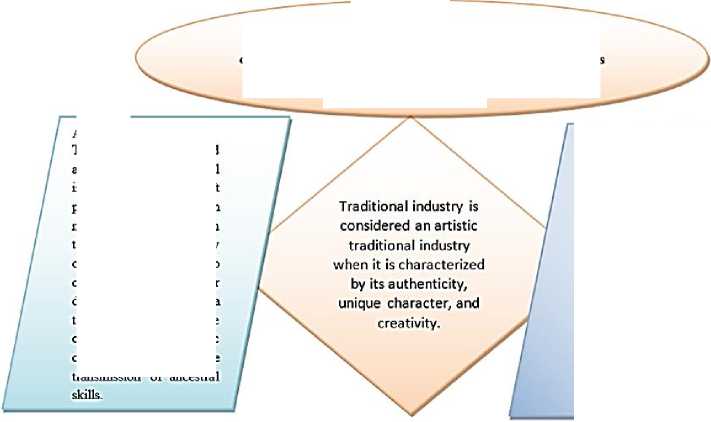
Article 05:
According to the meaning of this Ordinance, traditional industry and crafts refer to any activity of production, creation, transformation, artistic restoration, maintenance, repair, or provision that predominantly i and practiced: primarily and permanently, in stable, mobile, exhibition-based form..
Ordinance No. 96-01 dated 19 Sha’ban 1416
corresponding to January 10, 1996, defining the rules governing traditional industry and crafts

Article 06:
Traditional industry and traditional
industry refer to any craft predominantly based on manual work, in which the artisan may occasionally use took to create utilitarian and/or decorative items of a traditional nature. These crafts possess an artistic character that allows the transmission of ancestral
The Stages of Traditional Crafts and Industries in Ahaggar:
Based on our field study and the interviews conducted with a group of elderly practitioners of these crafts, we have identified the following stages in the development of traditional industries in the Ahaggar region:
01 – Pre-colonial Stage:
This period witnessed slow industrial development characterized by simplicity. Most artisans (Inedan) came from neighboring regions such as Aïr and Azawagh, which were known for Tuareg settlement. Trade caravans played a role in developing traditional industries by supplying raw materials and facilitating the movement of craftsmen to and from Ahaggar. The focus during this time was mainly on weapon-making (swords, spears, shields) and some wooden utensils.
02 – Colonial Stage:
With the expansion of French colonial control in the north and the Sahara, colonialism had a significant impact on all aspects of cultural, social, and economic life. In the northern regions, the colonial authorities redirected the population’s attention from traditional crafts to agriculture.
Secondly, cheaper and higher-quality European goods were imported, leading to unfair competition with local products.
Thirdly, traditional crafts were neglected by the colonial administration and received no support. In contrast, in the Ahaggar region, there was interest in encouraging traditional crafts and efforts to preserve the region's cultural heritage. Artisans focused on leatherwork (tents and furnishings), weapon-making, and woodcraft. Interest in jewelry-making also began to grow during this phase, depending on available raw materials.
03 – Post-independence Stage:
When Algeria gained independence, there was a renaissance in all fields. Tangible cultural heritage, including traditional crafts, received significant attention with the creation of dedicated government bodies such as the Ministry of Culture and the Ministry of Tourism.
From the 1970s to around 2010, this sector witnessed noticeable growth in the Ahaggar region due to the availability of raw materials, the revival of tourism, and the active participation of artisans—particularly the Asaghan Cooperative since its foundation and before—in numerous national and international festivals.
The artisans' desire to preserve their ancestral heritage and ensure its continuity also played a vital role in this development.
Factors Influencing the Development of Crafts and Traditional Industries in Ahaggar:
-
• Availability of raw materials of plant, animal, mineral, and stone origin.
-
• Marketing through Saharan tourism and exhibitions.
-
• State support for craft activities through the establishment of the Chamber of Traditional Industries.
-
• The family-based nature of handicrafts, which is a key factor in their continuity.
-
• Training children and encouraging them in these crafts by granting them the freedom to be creative and innovative.
-
• Preserving the transmission factor, as the risk of loss is clearly visible amid current changes.
Field Study:
As part of the fieldwork, we visited the “Sourou El-Mouallemine” neighborhood, which is well known for its artisans’ workshops in the region. There, we met Mr. Ben Abdallah Nour El-Din, who provided us with valuable information about the names of the oldest artisan families in Ahaggar. He also directed us to the eldest Inedan (craftsmen) from each family, considering age to be an important factor in terms of experience and knowledge regarding the history of these crafts in the region and their various products, as well as the artistic aspect represented through the use of different symbols.
Afterward, we engaged with the targeted sample group to shed light on various aspects of this craft. We used open guided interviews to gather information about the use and origins of the symbols.
> Study Sample Description:Asaghan Cooperative for Traditional Industry – Ahaggar.
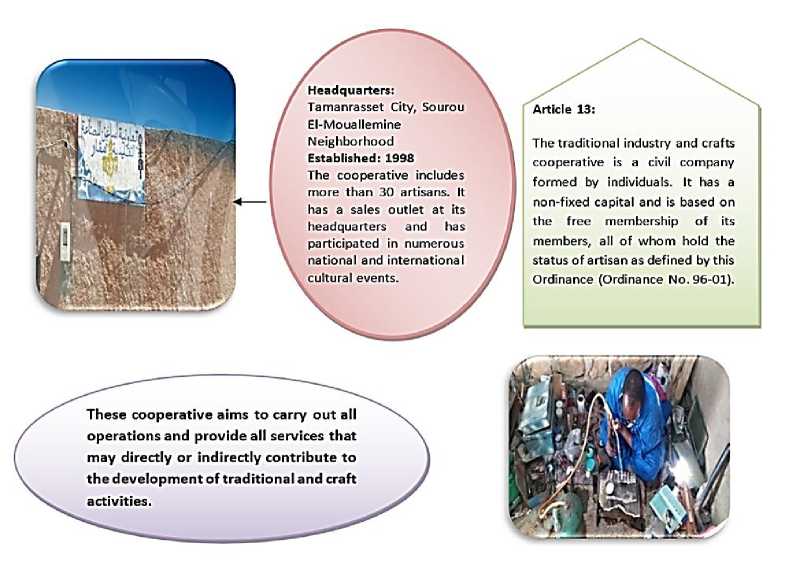
Article 13:
Headquarters:
Tamanrasset City, Sourou EI-Moua liemine Neighborhood Established: 1998 The cooperative includes more than 30 artisans. It has a sales outlet at its headquarters and has participated in numerous national and international cultural events.
These cooperative aims to carry out all operationsand provide all services that may directly or indirectly contribute to the development of traditional and craft activities.
The traditional industry and crafts cooperative is a civil company formed by individuals. It has a non-fixed capital and is based on the free membership of its members, all of whom hold the status of artisan as defined by this Ordinance (Ordinance No. 96-01).
This cooperative plays a significant role in preserving tangible heritage, represented by various artistic products related to our topic. The artisans of the Asaghan (Union) Cooperative have demonstrated that the continuity of this heritage is a shared responsibility. One finds children, adults, and the elderly exchanging knowledge and creating an atmosphere that ensures the transmission and appreciation of this heritage through various means and methods.
-
> Artistic Products for Which the Asaghan Cooperative in Sourou is Known:
The local artist has excelled in producing various artistic items inherited from the ancestors. Among the most renowned products of the Asaghan Cooperative are:
